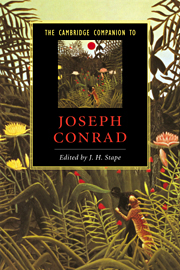5 - Nostromo
Published online by Cambridge University Press: 28 May 2006
Summary
In 1907, Conrad wrote to his literary agent, J. B. Pinker, that 'the public mind runs on questions of war and peace and labour'. He adds that he plans 'to treat those subjects ... from a modern point of view' (Letters, III, pp. 439- 40). These matters had become his subject already, however, when he wrote Nostromo four years earlier, and they continued to preoccupy him for the rest of his life. Labour relations had figured largely in his fiction even earlier, since 1897 when The Nigger of the 'Narcissus' and other sea stories presented sea-captains like Allistoun, and Marlow in Africa, managing their sometimes mutinous subaltern officers and crews. Nostromo is the first to introduce the other, equally 'modern', topic of 'war and peace', which for Conrad turns out to mean revolution and its consequences in a post-colonial world.
Readers for generations have related Nostromo to Leo Tolstoy's War and Peace (1869). The Russian novel may not have been a deliberate model, yet similarities abound: the vast compass of history the two novels re-enact, the celebration of a nation's repulse of an invading army, and the multiple plots and family histories that centre on the making of marriages and the reasons for their success or failure.
- Type
- Chapter
- Information
- The Cambridge Companion to Joseph Conrad , pp. 81 - 99Publisher: Cambridge University PressPrint publication year: 1996
- 1
- Cited by



